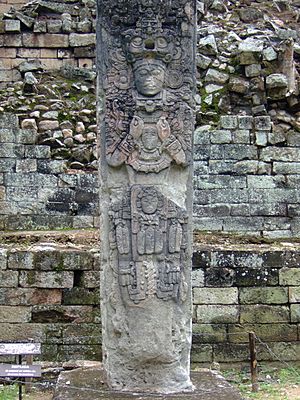Kʼakʼ Chan Yopaat facts for kids
Quick facts for kids Kʼakʼ Chan Yopaat |
|
|---|---|
| Ajaw | |

Kʼakʼ Chan Yopaat's portrait on Stela P
|
|
| King of Copán | |
| Reign | 19 November 578 - 5 February 628 |
| Predecessor | Tzi-Bʼalam |
| Successor | Chan Imix Kʼawiil |
| Born | 6th century Copán |
| Died | 5 February 628 Copán |
| Issue | Chan Imix Kʼawiil |
| Father | Tzi-Bʼalam |
| Religion | Maya religion |
Kʼakʼ Chan Yopaat was an important king of the ancient Maya city of Copán. He was the eleventh ruler in a long line of kings from the same family. He became king in 578 AD, just a few weeks after the previous king, Tzi-Bʼalam, passed away.
During Kʼakʼ Chan Yopaat's time, Copán was growing very quickly. More and more people were moving to the city, and new homes were being built everywhere in the Copán Valley. He ruled for a very long time, nearly 50 years, and died in 628 AD.
The Reign of Kʼakʼ Chan Yopaat
Kʼakʼ Chan Yopaat's rule lasted for 49 years, from 578 AD to 628 AD. This was a significant period for Copán, as the city experienced a large increase in its population. More people meant the city needed more space, and homes began to spread across the entire valley.
Ancient Stone Monuments
Two important stone monuments, called stelae, from Kʼakʼ Chan Yopaat's time are still standing today. These stelae are tall, carved stone slabs that often tell stories or record events. His stelae are special because they are the oldest ones at Copán that are still unbroken and were not buried.
These stelae have long messages written in hieroglyphs, which are like ancient picture-writing. These messages are quite difficult for experts to understand completely even today.
His Legacy in Copán
Even after his death in 628 AD, Kʼakʼ Chan Yopaat was remembered by later kings. His name appears on four stelae that were put up by kings who ruled after him. One of these stelae, created almost a hundred years later in 730 AD, describes a special ceremony. This ceremony involved using items from Kʼakʼ Chan Yopaat's tomb, showing how important he remained to the people of Copán.

